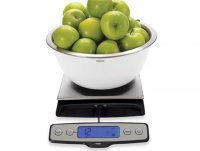kitchen weighing scale machine

Kitchen Scales: 6 Things to Know Before You Buy
Designed to accurately and precisely weigh food ingredients so that you can skip the guesswork, kitchen scales are an indispensable kitchen tool. Use them to measure out the desired amount of foods according to dietary requirements, or just to more accurately measure various ingredients for your baking and cooking. Widely-used in Europe, many recipes feature ingredients measured by weight. Cooks in every country find kitchen scales a useful addition to their kitchen.
Before purchasing a scale for your kitchen, weigh in on the following six tips for choosing the best model for your needs.
1. Analog versus Digital
There are two types of kitchen scales from which to choose. Analog, or mechanical scales, consist of an inner spring that shows the weight with a rotating pin. Electronic or digital scales run on batteries and display the weight on a digital readout. They also tend to feature a variety of additional capabilities, including the fact that some models can store data. Most of today’s kitchen scales are digital models. The digital readout shows a decimal value, which is usually accurate to the nearest tenth of a unit.
2. Capacity and Sensitivity
Consider what foods you will most likely weigh in order to determine how much capacity you require in a kitchen scale. Some especially sensitive scales are ideal for weighing up to 16 ounces, including lightweight items like herbs, spices and nuts. Other types of scales can handle up to 15 pounds. The latter scales are appropriate for weighing heftier items like large cuts of meat and whole poultry.
3. Enhanced Digital Features
Digital scales possess a wide variety of features that you may find useful, depending on your goals. Such perks include the machine’s ability to switch between various units of measurement, including pounds, ounces, grams and kilograms. Another helpful feature is a tare function, which enables the scale to consider the weight of the container and only display the weight of the contents. Some models also possess a baker’s timer and clock.
There are even scales that are programmed with calorie readings for various foods. Such models allow you to add your own recipes and food entries, and some have a memory feature that tracks your calories.
4. Platform and Container
Platform sizes vary. It is often a good idea to get a scale with a generous-sized platform so that you have room to weigh a variety of foods. Also choose a scale that comes with a container that holds the foods for weighing, including dry and wet ingredients. Make sure it’s removable for easy cleanup. Some models come with a measuring bowl attachment, which allows you to easily measure out ingredients.
5. Easy-to-Read
Not all digital displays are created equal. Some are small and hard to read, so test out each model if possible and opt for a large digital display. Also look for displays that don’t get hidden when you cover the scale with items to weigh.
6. Design and Ease of Storage
If you store the scale on your kitchen counter, it’s important to choose a model that fits well and adds to the look of your kitchen. A wide variety of styles exist, with many in stainless steel, which adds a sleek look to your kitchen.
Related posts:

 One of the more cost-effective measurements in a paper mill is that which monitors the flow of pulp stock into the head box of the paper machine. The stock level…
One of the more cost-effective measurements in a paper mill is that which monitors the flow of pulp stock into the head box of the paper machine. The stock level… Why is taking all the tricks called a boston in pinochle what are kegel exercises How to change administrator on windows 10? In what order should you learn tricks…
Why is taking all the tricks called a boston in pinochle what are kegel exercises How to change administrator on windows 10? In what order should you learn tricks… Overview Marel Marine Scales are specifically designed for use on board fishing vessels and factory trawlers. This cost-effective series of scales ranges from the…
Overview Marel Marine Scales are specifically designed for use on board fishing vessels and factory trawlers. This cost-effective series of scales ranges from the… How long to air fry french fries what does fafsa stand for What does it mean when ypu use alocohol and the tips of your fingers turn white Who raps bitches aint…
How long to air fry french fries what does fafsa stand for What does it mean when ypu use alocohol and the tips of your fingers turn white Who raps bitches aint… Globe s portion control scales can be used in a wide spectrum of applications from delis and pizza parlors, to bakeries and restaurants, or any establishment where…
Globe s portion control scales can be used in a wide spectrum of applications from delis and pizza parlors, to bakeries and restaurants, or any establishment where…